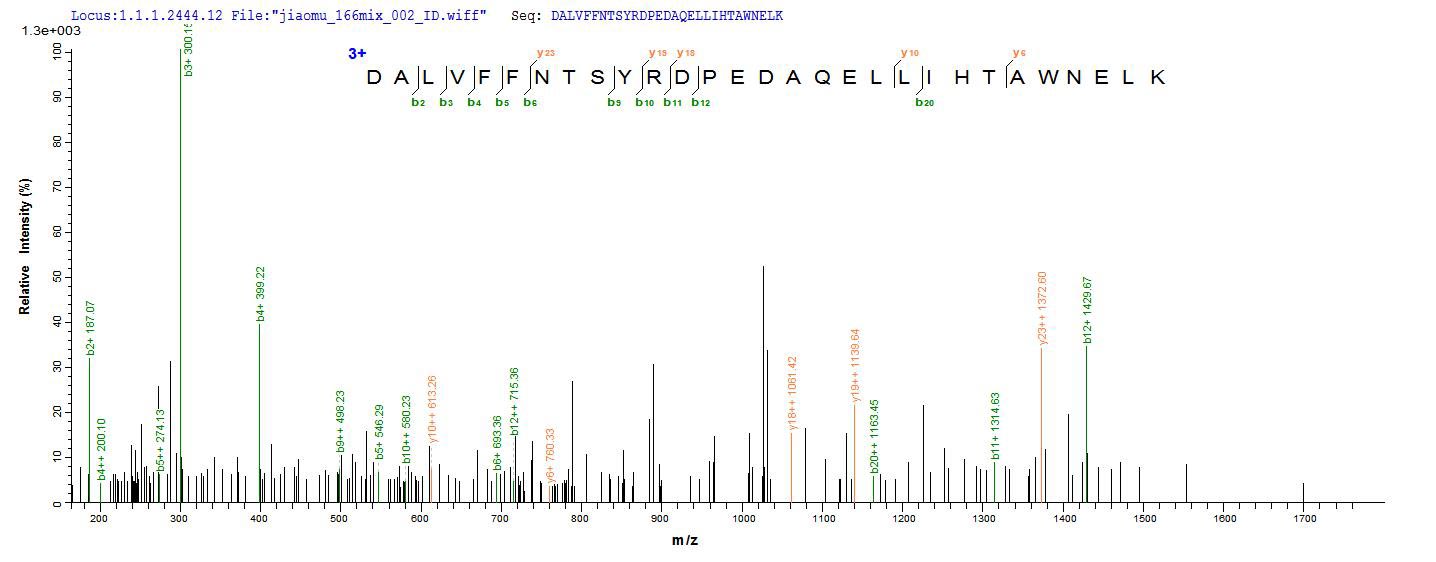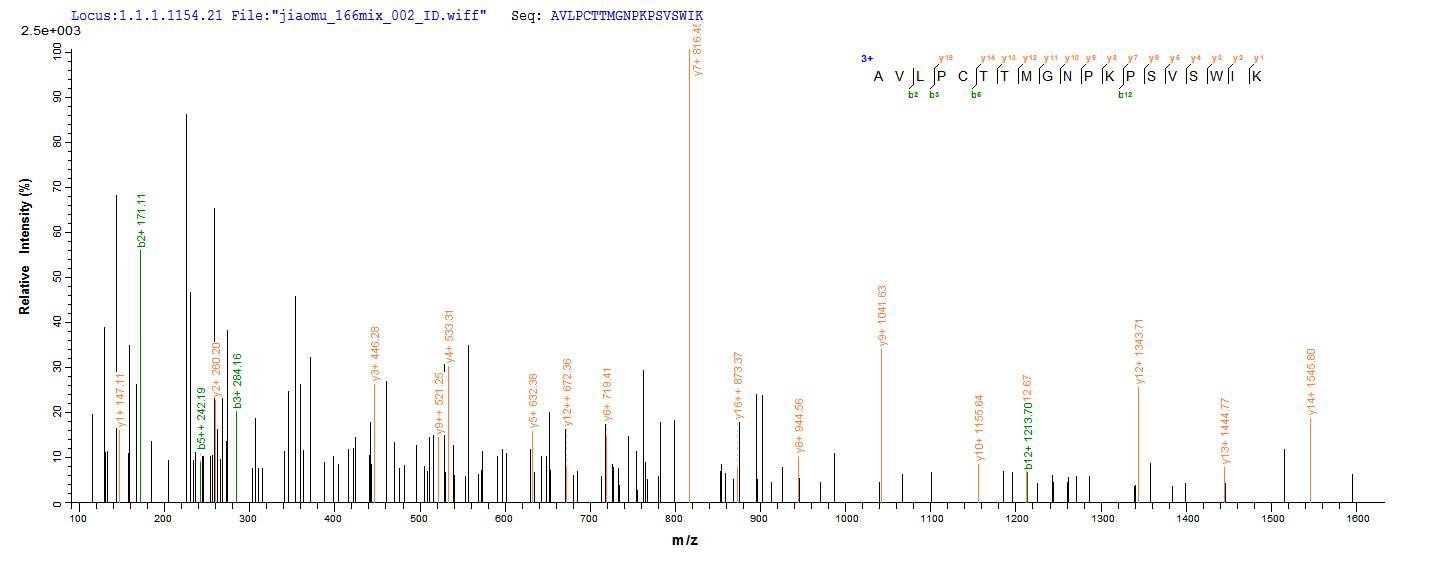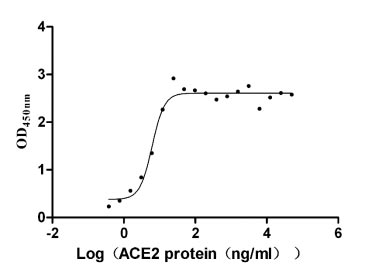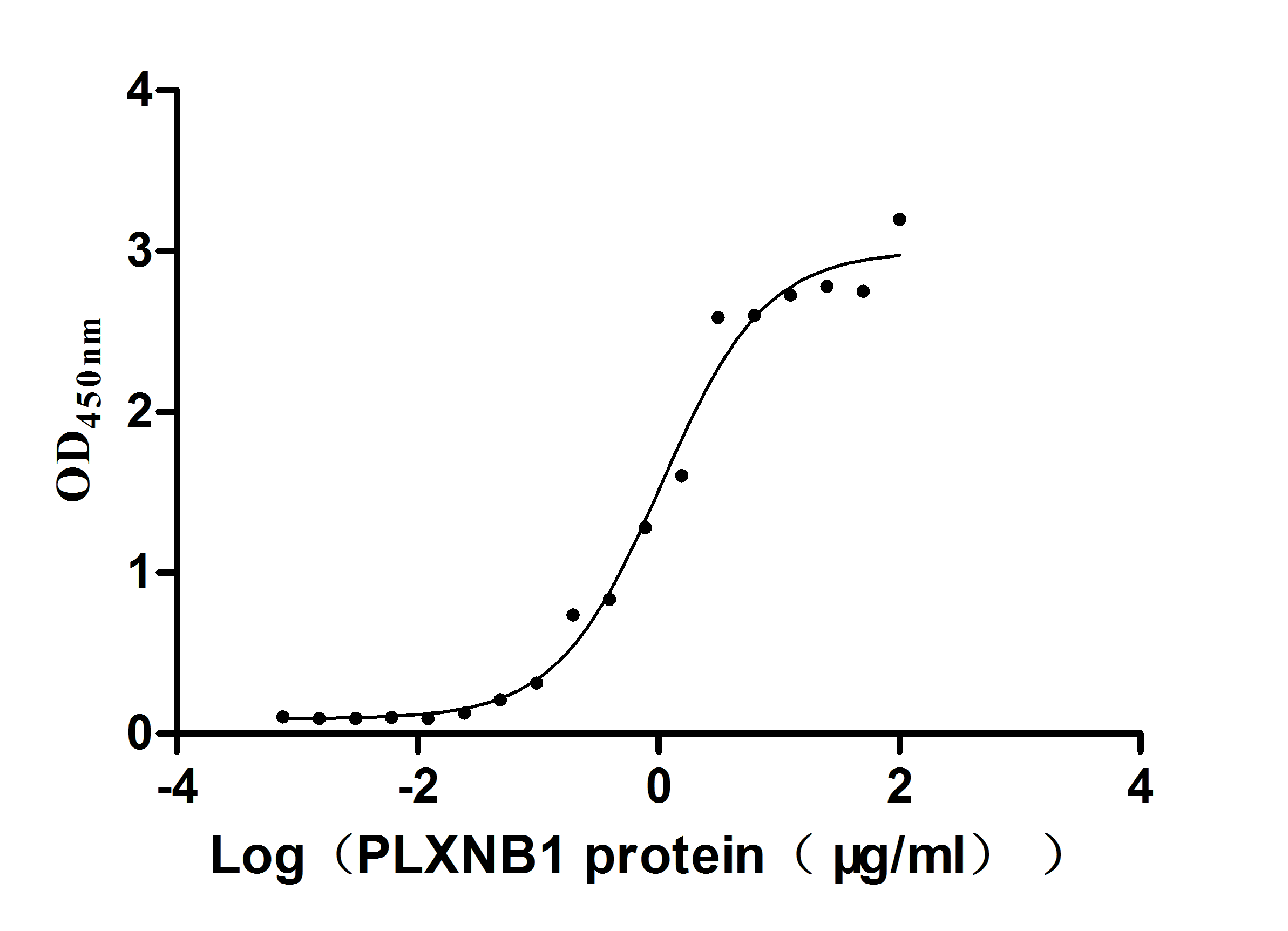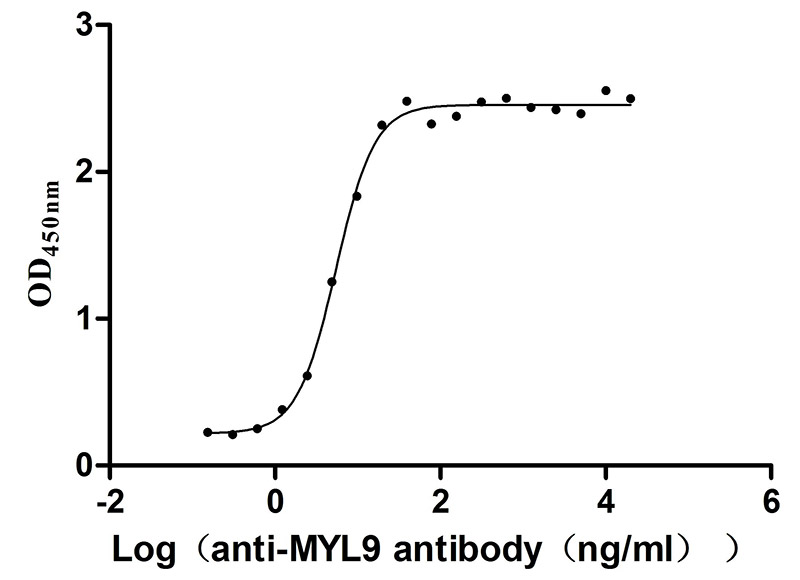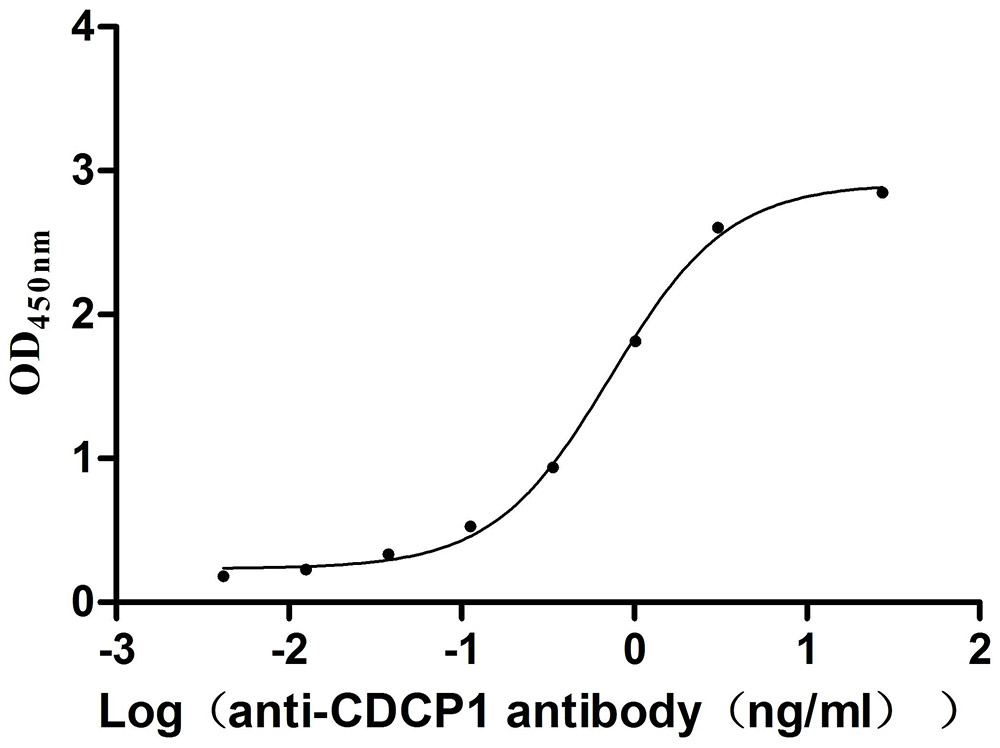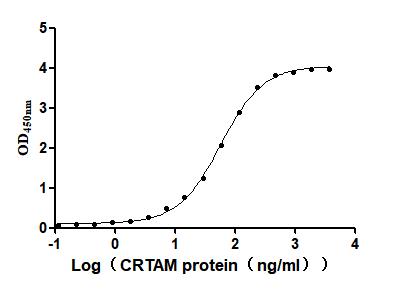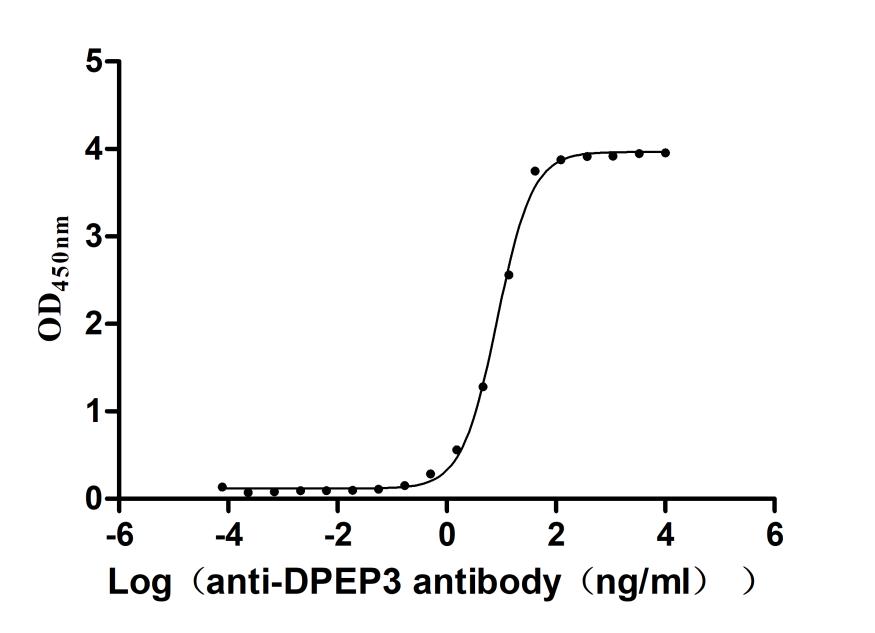Recombinant Mouse Muscle, skeletal receptor tyrosine-protein kinase (Musk),Partial
In Stock-
中文名称:小鼠Musk重组蛋白
-
货号:CSB-EP730715MO
-
规格:¥1836
-
图片:
-
(Tris-Glycine gel) Discontinuous SDS-PAGE (reduced) with 5% enrichment gel and 15% separation gel.
-
Based on the SEQUEST from database of E.coli host and target protein, the LC-MS/MS Analysis result of CSB-EP730715MO could indicate that this peptide derived from E.coli-expressed Mus musculus (Mouse) Musk.
-
Based on the SEQUEST from database of E.coli host and target protein, the LC-MS/MS Analysis result of CSB-EP730715MO could indicate that this peptide derived from E.coli-expressed Mus musculus (Mouse) Musk.
-
-
其他:
产品详情
-
纯度:Greater than 90% as determined by SDS-PAGE.
-
基因名:Musk
-
Uniprot No.:
-
别名:Musk; Nsk2; Muscle; skeletal receptor tyrosine-protein kinase; EC 2.7.10.1; Muscle-specific tyrosine-protein kinase receptor; MuSK; Muscle-specific kinase receptor
-
种属:Mus musculus (Mouse)
-
蛋白长度:Extracellular Domain
-
来源:E.coli
-
分子量:69.3kDa
-
表达区域:22-494aa
-
氨基酸序列EKLPKAPVITTPLETVDALVEEVATFMCAVESYPQPEISWTRNKILIKLFDTRYSIRENGQLLTILSVEDSDDGIYCCIANNGVGGAVESCGALQVKMKPKITRPPINVKIIEGLKAVLPCTTMGNPKPSVSWIKGDNALRENSRIAVLESGSLRIHNVQKEDAGQYRCVAKNSLGTAYSKLVKLEVEVFARILRAPESHNVTFGSFVTLRCTAIGIPVPTISWIENGNAVSSGSIQESVKDRVIDSRLQLFITKPGLYTCIATNKHGEKFSTAKAAATVSIAEWSKSQKDSQGYCAQYRGEVCDAVLAKDALVFFNTSYRDPEDAQELLIHTAWNELKAVSPLCRPAAEALLCNHLFQECSPGVVPTPMPICREYCLAVKELFCAKEWQAMEGKAHRGLYRSGMHLLPVPECSKLPSMHRDPTACTRLPYLDYKKENITTFPSITSSRPSADIPNLPASTSSFAVSPAYSMT
Note: The complete sequence including tag sequence, target protein sequence and linker sequence could be provided upon request. -
蛋白标签:N-terminal 10xHis-SUMO-tagged and C-terminal Myc-tagged
-
产品提供形式:Liquid or Lyophilized powder
Note: We will preferentially ship the format that we have in stock, however, if you have any special requirement for the format, please remark your requirement when placing the order, we will prepare according to your demand. -
缓冲液:If the delivery form is liquid, the default storage buffer is Tris/PBS-based buffer, 5%-50% glycerol.
Note: If you have any special requirement for the glycerol content, please remark when you place the order.
If the delivery form is lyophilized powder, the buffer before lyophilization is Tris/PBS-based buffer, 6% Trehalose. -
储存条件:Store at -20°C/-80°C upon receipt, aliquoting is necessary for mutiple use. Avoid repeated freeze-thaw cycles.
-
保质期:The shelf life is related to many factors, storage state, buffer ingredients, storage temperature and the stability of the protein itself.
Generally, the shelf life of liquid form is 6 months at -20°C/-80°C. The shelf life of lyophilized form is 12 months at -20°C/-80°C. -
货期:3-7 business days
-
注意事项:Repeated freezing and thawing is not recommended. Store working aliquots at 4°C for up to one week.
-
产品描述:肌肉骨架骨骼骨骼受体酪氨酸激酶(MuSK)是一种跨膜蛋白质,主要表达在神经肌肉突触。MuSK是乙酰胆碱受体信号传导途径的关键组成部分,对神经肌肉连接的形成和维持至关重要。华美生物提供的重组小鼠MuSK蛋白是通过大肠杆菌表达系统制备而成,表达区域为22-494aa。该产品在神经肌肉生物学、肌肉发育和神经肌肉突触形成等方面有着广泛的应用。MuSK是乙酰胆碱受体信号传导途径中的关键分子,参与了神经肌肉连接的形成和维持。深入了解MuSK在神经肌肉突触形成、神经肌肉疾病等方面的生物学机制。此外,对MuSK的研究还有助于理解肌肉发育和神经肌肉疾病的分子层面机制。
-
Datasheet & COA:Please contact us to get it.
相关产品
靶点详情
-
功能:Receptor tyrosine kinase which plays a central role in the formation and the maintenance of the neuromuscular junction (NMJ), the synapse between the motor neuron and the skeletal muscle. Recruitment of AGRIN by LRP4 to the MUSK signaling complex induces phosphorylation and activation of MUSK, the kinase of the complex. The activation of MUSK in myotubes regulates the formation of NMJs through the regulation of different processes including the specific expression of genes in subsynaptic nuclei, the reorganization of the actin cytoskeleton and the clustering of the acetylcholine receptors (AChR) in the postsynaptic membrane. May regulate AChR phosphorylation and clustering through activation of ABL1 and Src family kinases which in turn regulate MUSK. DVL1 and PAK1 that form a ternary complex with MUSK are also important for MUSK-dependent regulation of AChR clustering. May positively regulate Rho family GTPases through FNTA. Mediates the phosphorylation of FNTA which promotes prenylation, recruitment to membranes and activation of RAC1 a regulator of the actin cytoskeleton and of gene expression. Other effectors of the MUSK signaling include DNAJA3 which functions downstream of MUSK. May also play a role within the central nervous system by mediating cholinergic responses, synaptic plasticity and memory formation.
-
基因功能参考文献:
- Gene expression profiling showed that MuSK was required for the BMP4-induced expression of a subset of genes in myoblasts, including regulator of G protein signaling 4 (Rgs4). PMID: 27601729
- These mice showed only marginal activation of MuSK and died by 3 weeks of age apparently due to an abnormally small number and size of neuromuscular junction (NMJs). PMID: 28069867
- data reveal that muscle skeletal receptor tyrosine kinase cysteine-rich domain is critical for neuromuscular junction formation and plays an unsuspected role in NMJ maintenance in adulthood. PMID: 25810523
- Forced expression of Dok-7 in muscle enhanced MuSK activation in mice lacking agrin or Lrp4 and restored midmuscle NMJ formation in agrin-deficient mice, but not in Lrp4-deficient mice. PMID: 25368159
- pathogenic IgG4 antibodies to MuSK bind to a structural epitope in the first Ig-like domain of MuSK, prevent binding between MuSK and Lrp4, and inhibit Agrin-stimulated MuSK phosphorylation. PMID: 24297891
- MuSK colocalizes with actin and Arf6 at the cell surface and during endosomal trafficking. PMID: 23621612
- Increasing MuSK activity delays denervation and improves motor function in ALS mice. PMID: 22939980
- Two classic synaptic signalling systems (neuregulin-1 and neural agrin) converge upon MuSK to regulate postsynaptic differentiation. PMID: 22328506
- Biglycan binding to MuSK rescues the unstable acetylcholine receptor clusters that are involved in neuromuscular junction formation and postsynaptic differentiation. PMID: 22396407
- Data suggest that adult skeletal muscles harbour different endogenous levels of MuSK and that these levels determine the ability to form ectopic AChR clusters upon overexpression of agrin or MuSK. PMID: 21255125
- Depletion of MuSK at the neuromuscular junction leads to disassembly of muscle-specific kinase and muscle weakness of myasthenia gravis in mice. PMID: 20603331
- Data show that expression of a chimeric receptor containing the juxtamembrane region of Musk and the kinase domain of TrkA restores presynaptic and postsynaptic differentiation in Musk-deficient mice. PMID: 12403715
- Activation of a musk promoter reporter construct in muscle fibers in vivo and in cultured myotubes, using transfection of multiple combinations of expression vectors for potential signaling components PMID: 12756238
- analysis of regulation of MuSK expression by a novel signaling pathway PMID: 12885777
- Our results suggest that muscle tyrosine phosphatases tightly regulate MuSK activation and signaling and support a novel role of Shp2 in MuSK-dependent AChR clustering. PMID: 15737732
- Musk expression was inhibited by CREB interacting with a CRE-like element with MyoD. PMID: 15964791
- Our findings demonstrate that MuSK kinase activity is required throughout postnatal development to hold up MuSK and AChR levels at endplates. PMID: 16337809
- A low-molecular weight isoform of muscle-specific receptor tyrosine kinase in mouse sperm localized in the flagellar mid-piece region of human sperm. PMID: 16487930
- These results demonstrate a novel pathway linking the NO-soluble guanylyl cyclase-cGMP pathway, SR Ca2+ release, PLB, and CaM kinase II to relaxation in gastric fundus smooth muscles. PMID: 16510846
- Dok-7 is essential for neuromuscular synaptogenesis through its interaction with MuSK PMID: 16794080
- muscle-specific receptor tyrosine kinase activation and binding to dystroglycan are regulated by alternative mRNA splicing of agrin PMID: 17012237
- A new member of the Shc family of docking proteins is characterised, which may mediate a specific aspect of signaling downstream of the MuSK receptor. PMID: 17452444
- MuSK controls where motor axons grow and form synapses. PMID: 18084289
- the COOH-terminal NES and Src homology 2 target motifs play key roles in Dok-7/MuSK signaling for neuromuscular synaptogenesis. PMID: 18165682
- The IGg1/2 domain of MuSK is involved in acetylcholine receptor clustering by binding to the muscle surface. PMID: 18253062
- Our study reveals a potentially novel mechanism that regulates agrin/MuSK signaling cascade. PMID: 18272689
- adult musk(V789M/-) mice show severe muscle weakness; diaphragm exhibits pronounced changes in endplate architecture, distribution & innervation; missense mutation V789M in MuSK acts as a hypomorphic mutation & leads to insufficiency in MuSK function PMID: 18718936
- These experiments indicate that Lrp4 is the long-sought and elusive receptor for Agrin and has a critical role in activating MuSK and stimulating neuromuscular synapse formation. PMID: 18848351
显示更多
收起更多
-
亚细胞定位:Cell junction, synapse, postsynaptic cell membrane; Single-pass type I membrane protein. Note=Localizes to the postsynaptic cell membrane of the neuromuscular junction.
-
蛋白家族:Protein kinase superfamily, Tyr protein kinase family
-
组织特异性:Expressed preferentially in skeletal muscle.
-
数据库链接:
Most popular with customers
-
Recombinant Paguma larvata Angiotensin-converting enzyme 2 (ACE2), partial (Active)
Express system: Mammalian cell
Species: Paguma larvata (Masked palm civet)
-
Recombinant Human Plexin-B1 (PLXNB1), partial (Active)
Express system: Mammalian cell
Species: Homo sapiens (Human)
-
Recombinant Human Myosin regulatory light polypeptide 9 (MYL9) (Active)
Express system: Yeast
Species: Homo sapiens (Human)
-
Recombinant Mouse CUB domain-containing protein 1 (Cdcp1), partial (Active)
Express system: Mammalian cell
Species: Mus musculus (Mouse)
-
Recombinant Mouse Cytotoxic and regulatory T-cell molecule (Crtam), partial (Active)
Express system: Mammalian cell
Species: Mus musculus (Mouse)
-
Recombinant Macaca fascicularis Dipeptidase 3(DPEP3) (Active)
Express system: Mammalian cell
Species: Macaca fascicularis (Crab-eating macaque) (Cynomolgus monkey)


